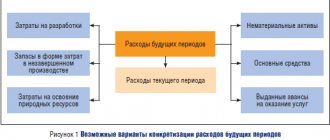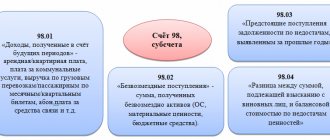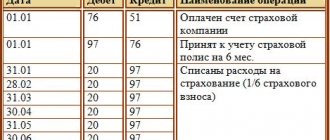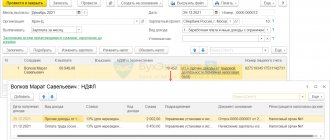Accounting for deferred income is considered when the income de jure does not relate to the period in which it was actually received or accrued. That is, it refers to some future period. We talk about accounting for future income.
First, about deferred income and what applies to them. According to the order of the Ministry of Finance of Russia dated October 31, 2000 No. 94n, which approved the Chart of Accounts for the financial and economic activities of organizations and the Instructions for its application, deferred income is:
- income received (accrued) in the reporting period, but relating to future reporting periods;
- upcoming receipts of debt for shortfalls identified in the reporting period for previous years;
- the difference between the amount to be recovered from the guilty parties and the value of the valuables accepted for accounting when shortages and damage are identified.
In relation to future income, postings are made using account 98 of the same name. It is passive (the balance is only on the loan) and synthetic.
Deferred income is reflected in detail, for example, in the following sub-accounts:
- 98-1 “Income received for future periods”;
- 98-2 “Gratuitous receipts”;
- 98-3 “Upcoming debt receipts for shortfalls identified in previous years”;
- 98-4 “The difference between the amount to be recovered from the guilty parties and the book value for shortages of valuables”, etc.
In the balance sheet, the credit balance of account 98 as of the reporting date is reflected on line 1530.
The reflection of future income is especially relevant for:
- accounting for fixed assets and other property received free of charge;
- accounting of budgetary funds;
- expected revenues under the leasing agreement.
Difficulties in determining deferred income (DBP)
To a layman it may seem that determining future income is not difficult. For example, creditor organizations owe certain funds, the repayment deadline is already approaching, logic dictates that the money will come to the account. Does such profit relate to DBP? Or another example: an order has been received for a large batch of goods, which means they paid good money for it, is this DBP?
In fact, both of these examples do not illustrate deferred income in an accounting sense.
Accounting cannot count money that is still in prospect of being received; this contradicts the very meaning of accounting, which operates on already completed, and not at all possible, transactions.
In the first case, the income is only inferred; until the debt is paid, it cannot be entered into any accounting accounts. In the second example, ownership of the goods occurs at the moment of its transfer to the buyer (shipment), so that income will occur only after payment and transfer of ownership. There is no talk about future income. Such and similar situations do not fall under the purview of accounting, but within the sphere of planning.
Deferred income is the receipt of an asset or the reduction of a liability resulting from transactions in the current accounting period, but reflected in the statements of other periods that have not yet occurred.
What objects belong to the DBP
Profit received “in advance” can be attributed to several cases of receipt of income. The main feature by which this type of income can be classified as DBP is that it can, in full accordance with the law, be “stretched” over several accounting periods, that is, this asset will be used to generate profit not only now, but also in the future. .
NOTE! All incoming funds that are recommended by the DBP are specified in regulatory (methodological) documents. An accountant should not expand their list on his own.
Recommendations for DBP are presented in the following regulatory documentation:
- clause 9 of PBU 13/2000 “Accounting for state aid” – on accounting for targeted financing as a DBP;
- clause 29 of the Methodological Guidelines for the Accounting of Fixed Assets speaks of reflecting gratuitously received finances as a loan on the DBP account;
- clause 4 of the Instructions on the reflection of leasing operations in accounting - on the presentation of leasing differences as DBP;
- Chart of accounts for accounting financial and economic activities - about the presence of account 98, specifically designed to reflect DBP;
- Order of the Ministry of Finance of the Russian Federation No. 66n dated July 2, 2010 “On the forms of financial statements of organizations” - on the reflection of financial statements in the balance sheet in the section “Short-term liabilities”.
How do deferred income affect the calculation of net assets ?
- Rent. The lease agreement may provide for payment in advance for a certain time. A security deposit, which is paid at the beginning of the lease, but is offset for its last month, can also be recognized as deferred income.
- Advance payments are funds transferred under a contract for goods or services that have not yet been provided to the buyer (in advance) on account of subsequent payments. DBP will be recognized if the advance is made more than 1 accounting period in advance.
- Subscription (prepayment) to periodicals.
- Sale of tickets for various events, performances, performances.
- Revenue from subscriptions and long-term obligations , for example, income from the transportation of passengers who bought a “pass” for a quarter or a year, subscription fees for communication services, etc.
- Sponsorship "gifts". For a long time, gratuitous receipts provided for in the gift agreement were attributed to the period of receipt, and tax was also reflected and paid on this profit. But if we consider this asset as a long-term asset that will “work” for the company for several years, then it can quite legitimately be considered as deferred profit. This also includes grants received.
- Funds from the budget received to cover costs.
- Funds allocated for specific purposes that are not fully used (fund balances in account 86 “Targeted financing”).
- When leasing, the difference between the amount of lease payments and the cost of the property leased (it must be on the balance sheet of the recipient of the property).
- Probable return of previous shortages . If a loss has been incurred, it can be irrecoverable (when the guilty party has not been identified) or it can be attributed to accounts receivable (when the amount is planned to be collected from the financially responsible person). In the second case, payment of such a shortfall may also be considered DBP.
- Leasing difference. If the company is a lessor, then the difference between the value of the property leased and the total amount of lease payments is also recognized as DBP. In this case, it does not matter that the property is already on the balance sheet of the lessee.
FOR YOUR INFORMATION! If fixed assets are received as a gift in this way, then depreciation in future periods will not be charged for them (otherwise it would level out the “profit” from deferring profits for the future), but the transfer of part of the DBP to current expenses is recorded. Thus, the cost will not include depreciation, which in this case will act as a transfer of expenses incurred earlier.
Question: When they talk about future income in tax accounting, as a rule, they mean income that needs to be recognized (distributed) over several reporting (tax) periods. In what cases should income be distributed? View answer
The contract does not provide for stages
If the terms of the concluded contracts do not provide for the phased delivery of work (services) and the technological cycle falls under the definition of long-term, then the income will be included in the taxable base even before the signing of the work completion certificate.
What is production with a long technological cycle? As the Ministry of Finance points out, this is a production whose start and end dates fall on different tax periods, regardless of the number of its days (Letters dated 02/05/2010 N 03-03-06/1/50, dated 10/13/2006 N 03-03-04/ 4/160).
According to this logic, a long cycle, for example, will be considered work (services) that can be completed in a few days if they started in December of one year and finished in January of the next. You can argue as much as you like about the legality of this approach, nevertheless, the tax authorities are in solidarity with the Ministry of Finance on this issue (see Letters of the Ministry of Taxes of Russia dated September 15, 2004 N 02-5-10/54, Federal Tax Service of St. Petersburg dated December 09, 2004 N 02-05/26961).
Now let’s assume another situation: an organization performs work under a contract from January to December within one year. Stage-by-stage delivery of work is not provided; the work completion certificate for the entire amount was signed on December 31. Should income be distributed at the end of each reporting period in this case, since the term of the contract falls within one tax period? According to the author, it should. After all, in para. 1 item 2 art. 271 of the Tax Code of the Russian Federation establishes that for income relating to several reporting (tax) periods, income is distributed by the taxpayer independently, taking into account the principle of uniform recognition of income and expenses.
So, under “no-stage” “long-term” contracts, income is subject to distribution. How can this be done?
According to the Ministry of Finance (Letters dated 06/09/2009 N 03-03-06/1/384, dated 10/13/2006 N 03-03-04/4/160), the price of the contract can be distributed by the taxpayer between reporting (note, the Ministry of Finance wrote - “reporting”) periods during which the contract is executed, in one of the following ways:
- evenly;
- in proportion to the share of actual expenses of the reporting period in the total amount of expenses provided for in the estimate.
The Tax Code does not limit the taxpayer in the method of income distribution. In addition to these two listed methods, we can recommend distribution in proportion to the volume of work performed in the reporting period in the total volume of work under the contract.
Let's look at examples of the methods recommended by the Ministry of Finance.
Method one - the organization evenly includes the income received during the contract period.
Example 2. An organization entered into an agreement to perform work on the installation of a building’s ventilation system in the amount of 15,000,000 rubles. (without VAT). The contract is valid from November 12, 2009 to April 10, 2010. However, the contract does not provide for phased delivery of work.
The accounting policy of the organization establishes:
— income from long-term contracts is recognized evenly over the term of these contracts;
— monthly advance payments are calculated based on the actual profit received. The reporting period for income tax is one month, two months, three months, etc.
We calculate the duration of work under the contract in calendar days. It will be 150 days (19 + 31 + 31 + 28 + 31 + 10).
For each day of work performed, an income of 100,000 rubles is generated. (RUB 15,000,000 / 150 days). Multiplying the amount of 100,000 rubles. by the number of days the contract is valid in a given month, we get the monthly amount of “deferred income”. It will be: in November 2009 - 1,900,000 rubles. (RUB 100,000 x 19 days), in December 2009 - RUB 3,100,000. (RUB 100,000 x 31 days), etc.
From arbitration practice. When choosing a temporary criterion that assumes an even distribution of income during the period of execution of the contract, it is necessary to take into account the following circumstance: established in paragraph 2 of Art. 271 of the Tax Code of the Russian Federation, the requirements will be fulfilled only if the performance of work under the contract involves the equal bearing of expenses. In the absence of this circumstance, it is more correct to apply the method of distributing income in proportion to the share of actual expenses of the reporting period in the total amount of expenses provided for in the estimate, which corresponds to clause 2 of Art. 271 of the Tax Code of the Russian Federation (this conclusion follows from the Resolution of the Federal Antimonopoly Service NWO dated April 10, 2009 N A42-4798/2007).
The second method is proportional to the share of actual expenses of the reporting period in the total amount of expenses provided for in the estimate. With this method, it is necessary to determine the method for estimating the total amount of expenses under the contract. It can be determined by estimated cost, by direct costs (in this case, both all direct costs and only labor costs can be used in the calculation), etc. The chosen method of distributing income relating to several reporting periods must be fixed in the accounting policy of the organization for tax purposes (Article 316 of the Tax Code of the Russian Federation).
Example 3. Let's use the data from example 2.
Option 1. The accounting policy of the organization establishes that income under long-term contracts that do not provide for phased delivery of work is recognized in proportion to actual expenses in the total amount of expenses under these contracts.
The volume of total expenses according to the estimate is 12,000,000 rubles.
The organization's actual expenses were: in November 2009 - 1,200,000 rubles, in December 2009 - 2,600,000 rubles, in January 2010 - 950,000 rubles. etc.
Let's calculate the amount that needs to be included in income:
- in November 2009 - 1,500,000 rubles. (1,200,000 x 15,000,000 / 12,000,000);
— in December 2009 — RUB 3,250,000. (2,600,000 x 15,000,000 / 12,000,000);
— in January 2010 — 1,125,000 rubles. (900,000 x 15,000,000 / 12,000,000) etc.
Option 2. The organization’s accounting policy establishes that income under long-term contracts that do not provide for phased delivery of work is recognized in proportion to the share of direct labor costs in the total estimated cost of work.
The cost of remuneration of the main workers according to the estimate is 5,000,000 rubles.
Actual expenses for paying them: in November 2009 - 400,000 rubles, in December 2009 - 800,000 rubles, in January 2010 - 300,000 rubles. etc.
Let's calculate the amount that needs to be included in income:
— in November 2009 — RUB 1,200,000. (400,000 x 15,000,000 / 5,000,000);
— in December 2009 — RUB 2,400,000. (800,000 x 15,000,000 / 5,000,000);
— in January 2010 — 900,000 rubles. (300,000 x 15,000,000 / 5,000,000) etc.
Note! The taxpayer's income from work and services with a long cycle is distributed in the manner chosen by the taxpayer and set forth in the accounting policy regulations. In this case, the attribution of incurred expenses to expenses of the reporting (tax) period is carried out by the taxpayer in the generally established manner. This is indicated by the Ministry of Finance in Letter dated 06/09/2009 N 03-03-06/1/384.
This means that taxpayers whose production is related to the performance of work (rendering services) take into account expenses as follows:
— the amount of indirect expenses incurred in the reporting (tax) period is included in full as expenses of the current reporting (tax) period;
— the amount of direct costs is distributed to the balances of work in progress in proportion to the share of unfinished orders in the total volume of orders for work (provision of services) completed during the month.
The procedure for distributing direct costs when performing “long-term” work under contracts that do not provide for phased delivery of work is reflected in Letter of the Ministry of Finance of Russia dated 02/04/2005 N 03-03-01-04/1/52. It is similar to the procedure outlined in example 1.
Let us recall the formula for calculating work in progress balances at the end of the month:
NZPkm = (NZPnm + PRmes) x DSRkm / DSR
In addition, the volume of work, services, income for which was taken into account in the reporting (tax) period, when calculating work in progress should be considered as work performed, services provided (see Letters of the Ministry of Finance of Russia dated July 30, 2004 N 03-03-05/1/88 , Ministry of Taxes and Taxes of Russia dated September 15, 2004 N 02-5-10/54). In example 3 (option 1), income includes the following amounts: in November 2009 - 1,500,000 rubles, in December 2009 - 3,250,000 rubles, in January 2010 - 1,125,000 rubles, and when calculating work in progress these amounts will be recorded as work completed.
Thus, when calculating the work in progress indicator, the specified volumes will not be included in the composition of unfinished (or completed, but not accepted at the end of the current month) orders for work, provision of services (DSRkm).
Let's explain this with an example.
Example 4. Let's use the data from example 3 (option 1).
Direct expenses amounted to: in November 2009 - 600,000 rubles, in December 2009 - 1,700,000 rubles, in January 2010 - 480,000 rubles. etc.
In November, the organization reflected income in the amount of RUB 1,500,000, so
Thus, the DSRkm indicator will be 13,500,000 rubles. (15,000,000 -1,500,000).
WIP at the end of November will be 540,000 rubles. ((0 + 600,000) x 13,500,000 / 15,000,000).
Direct expenses that reduce profit in November will amount to 60,000 rubles. (0 + 600,000 – 540,000).
Indicators for the following months are calculated in a similar way.
In December, the organization reflected income in the amount of 3,250,000 rubles, the DSRkm indicator will be 10,250,000 rubles. (15,000,000 - 1,500,000 - 3,250,000).
WIP at the end of December will be 1,530,667 rubles. ((540,000 + 1,700,000) x 10,250,000 / 15,000,000).
Direct expenses that reduce profit in December will amount to RUB 709,333. (540,000 + 1,700,000 – 1,530,667).
In January, the organization recorded income in the amount of RUB 1,125,000,
the DSRkm indicator will be 9,125,000 rubles. (15,000,000 - 1,500,000 - 3,250,000 - 1,125,000).
WIP at the end of January will be 1,223,156 rubles. ((1,530,667 + 480,000) x 9,125,000 / 15,000,000).
Direct expenses that reduce profit in January will amount to RUB 787,511. (1,530,667 + 480,000 – 1,223,156).
Indicators for the following months are calculated in a similar way - February, March, April.
Let's summarize the above: if the taxpayer does not want to argue with tax inspectors and at the same time does not want to pay income tax before signing the work completion certificate, it is better to draw up an agreement broken down into stages. Please note that it is not the payment under the contract that is “split” (for example, some contracts indicate that payment is made in two stages), but rather the work. Depending on the specifics of the work performed (services provided), the breakdown into stages can be made as a percentage of the total volume of work under the contract or by type of work.
By the way, the Tax Code does not establish restrictions on the number of stages, or on their duration, or on the comparability of volumes. It is also not necessary to link the delivery date of a particular stage to the payment deadlines.
Why allocate DBP
The matching principle that guides accounting states that income must be consistent with the expenses that generated the income. Sometimes a business receives assets, that is, income that is not specifically related to the current accounting period, because the expense is spread over a longer time. Theoretically, the funds could have been received over a long period, but they all arrived at once. In such situations, accountants prefer to report profit in an amount not exceeding the income of the current period, and transfer funds received that are not related to it to the DBP subaccounts.
Why do this, because you can immediately write down the entire asset received as profit? Yes, it is possible, but we should not forget that the amount of profit is directly proportional to the tax base. And if there is a legal opportunity to reduce it this year, why increase it by income that will only be used in the future?
EXAMPLE. The organization rents out real estate. She was paid rent for three years at once. The asset is there. If you record all of it in this year’s income, the amount of the income tax base will be increased. If you take into account only the payment for the current year as profit, then the remaining funds must be taken into account as DBP, reflecting them in the balance sheet of profit in the next two years, thus proportionally distributing the tax base.
The contract is “broken” into stages
If the contract provides for the stage-by-stage delivery of the results of work performed (services provided), the date of receipt of income will be the date of signing the act of stages completed and accepted by the customer.
As for the costs associated with production and sales, they are known to be divided into direct and indirect. According to paragraph 2 of Art. 318 of the Tax Code of the Russian Federation, the amount of indirect expenses in full relates to the expenses of the current reporting (tax) period. Direct expenses relate to the expenses of the current period as work and services are implemented in accordance with Art. 319 of the Tax Code of the Russian Federation, that is, taking into account the balances of work in progress (WIP).
Note! Taxpayers providing services have the right to attribute the amount of direct expenses incurred in the reporting (tax) period in full to the reduction of income from production and sales of this period without distribution to the balances of work in progress (clause 2 of Article 318 of the Tax Code of the Russian Federation).
For the purposes of ch. 25 of the Tax Code of the Russian Federation, work in progress means work, services that are partially completed, as well as those completed but not accepted by the customer. The taxpayer independently determines the procedure for distributing direct costs for work in progress and for work performed (services rendered). This procedure is established in the accounting policy for tax purposes and is subject to application for at least two tax periods (clause 1 of Article 319 of the Tax Code of the Russian Federation).
For example, a taxpayer may establish in an accounting policy that the amount of direct costs is distributed to WIP balances in proportion to the share of unfinished (or completed but not accepted at the end of the current month) orders in the total volume of orders completed during the month.
The volume of orders completed during a month is defined as the contractual value of orders that were actually completed in the current month. Moreover, the contractual value of unfinished orders is determined as for orders actually completed in the current month, minus the cost of all completed and transferred to the customer stages for these orders.
Example 1. An organization carries out development work. The accounting policy of the organization establishes:
— the calculation of the amount of work in progress at the end of the month is based on the contractual cost of the work performed;
— monthly advance payments are calculated based on the actual profit received. The reporting period for income tax is one month, two months, three months, etc.
In June, two contracts were concluded (to simplify the example, let’s assume that at the beginning of the month the organization had no unfinished work or “unclosed” contracts).
Agreement No. 1. The cost of work (excluding VAT) is 5,000,000 rubles. Completion date: July 12 - October 11, 2010. The work is being delivered in stages.
Stage I (July 12 - August 9) - 40% of the total volume of work performed.
Stage II (August 10 - October 11) - 60%.
Agreement No. 2. The cost of work (excluding VAT) is 10,000,000 rubles. The deadline is July 19 - November 19, 2010. The work is being delivered in stages.
Stage I (July 19 - September 17) - 75% of the total volume of work completed.
Stage II (September 18 - November 19) - 25%.
The deadlines for delivery of work specified in the contracts were met. Certificates of completed work were signed:
— August 9, 2010 — RUB 2,000,000. (I stage of agreement No. 1);
— September 17 — 7,500,000 rub. (I stage of agreement No. 2);
— October 11 — 3,000,000 rub. (II stage of agreement No. 1);
— November 19 — RUB 2,500,000. (II stage of agreement No. 2).
Due to the fact that the organization is not obliged to keep records of expenses separately for each contract, direct expenses during the month are taken into account in aggregate for all contracts. During the work, they amounted to:
— July 2010 — 900,000 rubles;
— August — 1,400,000 rubles;
— September — 1,500,000 rubles;
— October — 1,700,000 rubles;
— November — 500,000 rub.
Income from these two agreements in tax accounting will be generated as follows:
| Origination of income | Reflected in the declaration | |||
| Month | Base | Amount, rub. | Period | Amount, rub. |
| August | Dog. N 1, stage I | 2 000 000 | January - August | 2 000 000 |
| September | Dog. N 2, stage I | 7 500 000 | January - September | 9 500 000 |
| October | Dog. N 1, stage II | 3 000 000 | January - October | 12 500 000 |
| November | Dog. N 2, stage II | 2 500 000 | January - November | 15 000 000 |
As for expenses, we recall that the amount of indirect expenses incurred in the reporting (tax) period is fully included in the expenses of the current period. In this regard, data on indirect costs is not provided in the example. Direct expenses refer to the expenses of the current reporting (tax) period, taking into account work in progress.
Calculation of work in progress balances at the end of the month (when choosing the method “based on the contractual cost of work”) can be calculated using the formula:
NZPkm = (NZPnm + PRmes) x DSRkm / DSR,
where WIPkm is the amount of direct costs related to WIP at the end
reporting month;
WIPnm - the cost of the balance of WIP at the beginning of the month;
DSRkm - the cost of contracts not completed at the end of the month;
DSR - the cost of all contracts performed during the month;
PRmes - the amount of direct expenses incurred per month.
In tax accounting, direct expenses will be taken into account as follows.
In July, direct expenses accumulate and will be taken into account only during the period of reflection of sales income, that is, in August. Thus, the work in progress at the end of July will be 900,000 rubles.
In August, the organization reflected income from the implementation of the first stage of work under contract No. 1, in connection with which part of the direct costs can be written off as a reduction in the taxable base for income tax.
WIP at the end of August will be 1,993,333 rubles. ((900,000 + 1,400,000) x (5,000,000 - 2,000,000 + 10,000,000) / (5,000,000 + 10,000,000)).
Direct expenses that reduce profit in August will amount to RUB 306,667. (900,000 + 1,400,000 – 1,993,333).
Indicators for the following months are calculated in a similar way.
In September, the balance of work in progress at the end of the month is 1,280,889 rubles. ((1,993,333 + 1,500,000) x (5,000,000 - 2,000,000 + 10,000,000 - 7,500,000) / (5,000,000 + 10,000,000)).
Direct expenses that reduce profit in September will amount to RUB 2,212,444. (1,993,333 + 1,500,000 – 1,280,889).
In October, the balance of work in progress at the end of the month is 496,815 rubles. ((1,280,889 + 1,700,000) x (5,000,000 - 5,000,000 + 10,000,000 - 7,500,000) / (5,000,000 + 10,000,000)).
Direct expenses that reduce profit in October will amount to RUB 2,484,074. (1,280,889 + 1,700,000 – 496,815).
In November, the organization “closed” contract No. 2. Work on new contracts was not started this month, so direct expenses that reduce profit in November are equal to 996,815 rubles. (496,815 + 500,000).
Where are deferred income reflected?
Special account 98, which is called “Deferred Income,” is designed to reflect all types of deferred profits. The instructions for the Chart of Accounts allow you to open a number of sub-accounts for this account, specified by DBP objects:
- “income that will be received in future accounting periods”;
- “gratuitous receipts” – gifts, sponsorship, etc.;
- “future receipts for past shortfalls identified in earlier periods”;
- “the difference between the cost of recovery according to the balance sheet and the amount payable by the guilty party”, etc.
In the balance sheet, a special line 1530 is intended to account for this type of profit.
ATTENTION! It can reflect only those incomes that are recognized by the DBP in the regulatory documents of this organization.
What accounting data is used when filling out line 1530 “Deferred income” ?
Active or passive?
Are deferred receipts an asset or a liability when reflected on the balance sheet? Line 1530 reflects the item “DBP” as a balance sheet liability, despite the fact that it takes into account income.
The reason is that this line has a direct connection with another line, also related to the liability “Retained earnings (uncovered loss)”. It records the profit that the organization “owes” to its owners. But in practice, there are often situations when the debt to the owners has not yet arisen, but the money has already arrived on the balance sheet. For example, money was received as funding from the budget. They should be classified as “cash” assets. How to balance a liability? These are not retained earnings, because the organization has not yet done anything of what they were intended for, which means they have not yet become a profit. The profit from them is only in the future, so it is appropriate to include them in the liability line “Future income”. As this money is spent, that is, expenses are recognized, the amounts from the DBP liability will be transferred in parts to the Retained Earnings liability.
We carry out accounting
To reflect the DBP, the credit of account 98 “Deferred Income” and correspondent accounts are intended for accounting for finances and settlements with counterparties.
To write off amounts of income from future periods when this very “future” occurs, the debit of this account (98) is used, as well as the correspondence of the account in which the income was recorded (90 or 91, this determines the type of receipt).
Subaccounts that define a specific DBP object also provide for the corresponding correspondence:
- “Gratuitous receipts” – 08 “Investments in non-current assets”, 86 “Targeted financing” (loan 91 “Other income and expenses”);
- “Forthcoming receipts of debt for shortfalls for past periods” - 94 “Shortfalls from loss and damage to valuables”, 73 “Settlements with personnel for other operations”, subaccount “Reimbursement of material damage” (credit 91 “Other expenses”);
- “The difference in the amount of recovery from the perpetrator and the book value” - 73 “Settlements with personnel for other operations” (credit 91 “Other expenses”).
DBP inventory
IMPORTANT! A sample of filling out an inventory report for deferred income from ConsultantPlus is available here
For the adequacy of accounting for deferred profits, it is necessary to regularly inventory (check) this part of the balance sheet. The inventory includes:
- the correctness of attributing this type of profit specifically to future income;
- reconciliation of the correspondence of the amounts according to the “primary” (that is, whether they are reflected correctly in the documentation);
- clarification of how correct the reflection of funds is in relation to the accounting policies of this organization.
Upcoming income under the leasing agreement
When, under the terms of a leasing agreement, property is recorded on the lessee’s balance sheet, the difference between the total amount of lease payments and the cost of the leased property in the lessor’s accounting is reflected as follows (clause 4 of Appendix No. 1 to Order No. 15 of the Ministry of Finance dated February 17, 1997):
| Dt 76 “Settlements with various debtors and creditors” - Kt 98 |
When the lease payment is received, deferred income is written off. Namely, the part of the income of these periods attributable to him (clause 6 of Appendix No. 1 to Order of the Ministry of Finance dated February 17, 1997 No. 15):
| Dt 98 - Kt 90 “Sales” |






